Posts Tagged ‘attorneys’
Many Pedestrian Accidents in Massachusetts Since New Year
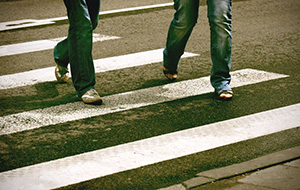 During the first two weeks of 2016, Massachusetts has already seen several serious pedestrian accidents.
During the first two weeks of 2016, Massachusetts has already seen several serious pedestrian accidents.
Last weekend, a 56-year-old security guard leaving work was killed in a hit-and-run accident on West Boylston Street in Worcester. Police have charged a 21-year-old man with motor vehicle homicide by negligent operation and other violations.
Last week, a 68-year-old pedestrian was killed in South Hadley, as he crossed the street in front of his home. In that case, the driver remained on the scene and police opened an investigation.
In Palmer, a 59-year-old pedestrian was killed while using a crosswalk at the intersection of North Main and Rockview streets. The pedestrian accident occurred about 5 p.m. in the day and the driver fled the scene.
Then in Cape Cod, a 19-year-old man was also killed when hit while crossing Route 28 in Yarmouth.
A few concerns for pedestrians in the winter:
Plow trucks. Last winter, at least two pedestrians in the Boston area were killed in parking lots by snow plow trucks. A 60-year-old employee at the Whole Foods store in Medford was struck and killed while walking across the store’s parking lot. A few days earlier, a Weymouth woman was hit and killed by a snow plow driver who was clearing the parking lot outside her condominium complex.
Parking lots. Pedestrians are just as vulnerable in parking lots as they are in streets. Last week, a pedestrian was hit in the South Street shopping plaza in Holyoke, in front of the Save-A-Lot supermarket.
Crosswalks. In Massachusetts, pedestrians who are crossing the street in a crosswalk or at an intersection with the “Walk” signal have the right of way. But drivers often fail to stop for pedestrians – and sometimes crossing guards. A crossing guard in Holyoke was struck by a car and injured at 8 a.m. one day last week.
About Our Experience
The Boston personal injury attorneys at Breakstone, White & Gluck have over 100 years combined experience representing individuals who have been injured in pedestrian accidents. Attorney Ronald E. Gluck recently negotiated a $1.25 million settlement for the family of a woman who was hit and killed in a crosswalk.
City of Boston to Lower Speed Limits to Reduce Traffic Fatalities
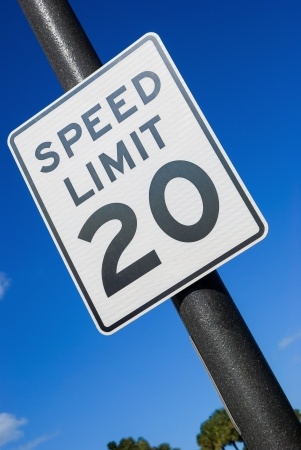 Good news for pedestrians and cyclists: the City of Boston plans to lower speed limits to 20 MPH in some neighborhoods. Officials will also advocate to lower Boston’s default speed limit to 25 MPH.
Good news for pedestrians and cyclists: the City of Boston plans to lower speed limits to 20 MPH in some neighborhoods. Officials will also advocate to lower Boston’s default speed limit to 25 MPH.
Mayor Marty Walsh released the city’s Vision Zero Action Plan last week, including the Neighborhood Slow Streets Program, which will be launched in 2016. A pilot program will introduce traffic calming measures and a 20 MPH speed limit to the Talbot-Norfolk Triangle in Dorchester and the Stonybrook neighborhood in Jamaica Plain. The full program will be launched later in the year and residents across the city can apply.
The default speed limit on local roads in Massachusetts is 30 MPH. The Massachusetts State Legislature must approve any change and it has not acted on past bills. The Metropolitan Area Planning Council, a proponent of the change, has said lowering the speed limit would prevent 2,200 car crashes, 18 fatalities and 1,200 injuries across the state each year. Some $210 million would be saved in medical payments and lost work.
In 2014, Boston Emergency Medical Services treated two to three people each day due to pedestrian and bicycle accidents.
Earlier this year, Mayor Walsh announced Boston would adopt Vision Zero to eliminate traffic fatalities and injuries by 2030. The far-reaching plan includes many infrastructure and technology changes, from the implementation of smart parking meters to building protected bike lanes in crash-ridden areas and better data collection among city departments.
Boston joins other cities around the world in adopting Vision Zero initiatives. The first was adopted in Switzerland nearly 20 years ago. In recent years, New York City, San Francisco and Chicago have adopted plans.
New York lowered its default speed limit from 30 MPH to 25 MPH last year and San Francisco city supervisors began discussing a 20 MPH speed limit last winter.
Read More
Breakstone, White & Gluck Answers Safety Questions about Bicycle Helmets
Breakstone, White & Gluck is pleased to be donating children’s bicycle helmets again this year through our Project KidSafe campaign. As part of this work, we get to go out and meet children and families at community events. Over the years, we have been asked some great questions about bicycle helmet use. Here are some of our answers:
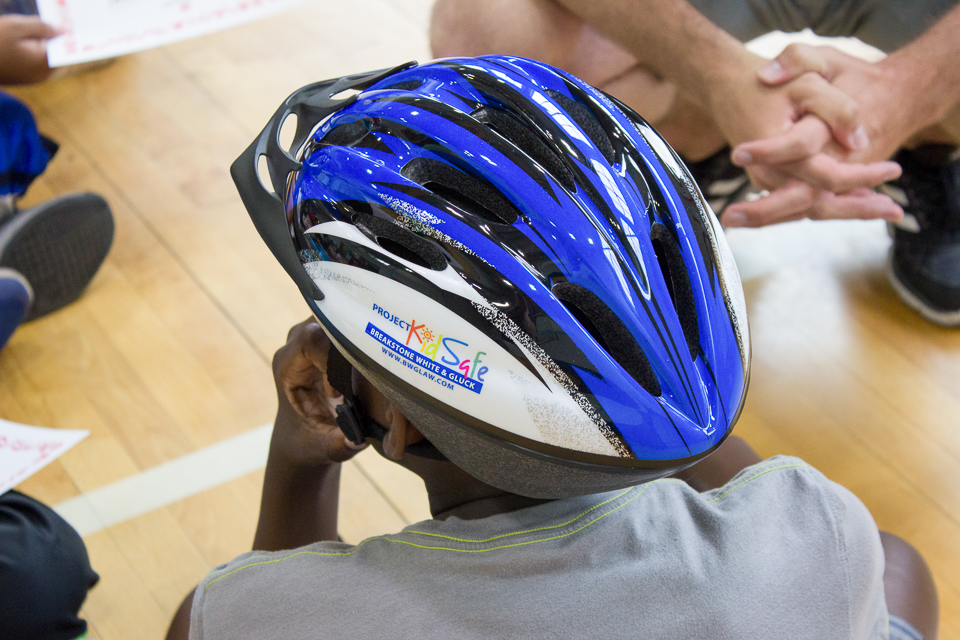
Do I Have to Wear a Bicycle Helmet?
Yes! Massachusetts law requires cyclists 16 years old and younger to wear bicycle helmets when they ride. If you want to learn more, the statute is M.G.L. c. 85 § 11B.
While the law does not require parents to wear helmets, we encourage you to do so. If you wear one, your children will follow your lead and take the message to heart. Wearing a bicycle helmet is the most effective step you can take to prevent a serious head injury if you are involved in a bicycle accident. This is a good lesson for your children to learn early on.
What Else Should I Know About the Law on Bicycle Helmets?
M.G.L. c. 85 § 11B states helmets must be secured to a person’s head by straps and meet the safety standards set by the U.S. Consumer Product Safety Commission.
When Should I Replace a Helmet?
Always replace helmets after a fall or bicycle accident, even if it does not appear damaged. Also replace the helmet if it no longer fits or the straps have worn. If the helmet is over three years old, it should be replaced.
Can Helmets be Handed Down from Child to Child?
Unlike bicycles, it is probably a better practice to not pass helmets down to younger siblings, unless they are still in excellent condition. If you are still considering re-using a helmet, think about how long the first child wore it and if they had any cycling accidents or falls. It is hard to know how many times a child has fallen, so the safe bet is to get a new helmet.
About Breakstone, White & Gluck and Project KidSafe
Breakstone, White & Gluck, a Boston personal injury law firm, launched our Project KidSafe campaign in 2013, with a goal of encourage safe bicycling. We have donated over 7,000 bicycle helmets to children throughout eastern Massachusetts and have worked with organizations such as Boston Bikes’ Roll It Forward, Massachusetts Safe Routes to Schools, Bikes Not Bombs and local bicycle committees and police departments.
Our attorneys have published safety and other informational materials for cyclists on our website:
What Every Massachusetts Cyclist Should Know About Car Insurance
Many cyclists are unaware they can purchase coverage for bicycle accidents through their car insurance policies. This is important because many drivers are underinsured or uninsured and many injured cyclists have to recover medical costs and other damages through their own car insurance policies. Read more.Massachusetts Bicyclists’ Rights and Responsibilities
Read a summary of the responsibilities of cyclists and motorists in Massachusetts.
Our Project KidSafe Campaign Continues in Arlington, Cambridge and Ashland
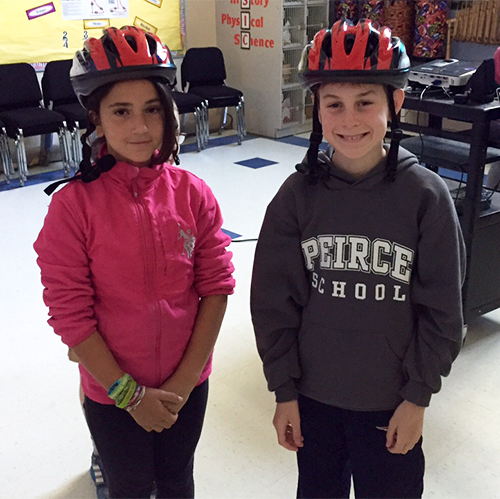 Breakstone, White & Gluck’s Project KidSafe campaign recently donated bicycle helmets in Arlington, Cambridge and Ashland. This has been our busiest year yet and we have been enjoying working with our friends, old and new.
Breakstone, White & Gluck’s Project KidSafe campaign recently donated bicycle helmets in Arlington, Cambridge and Ashland. This has been our busiest year yet and we have been enjoying working with our friends, old and new.
Windsor Street Health Center in Cambridge. We recently gained a new partner, the medical students at the Windsor Street Health Center in Cambridge. The helmets will be donated to children who visit the center and need one. Many families served by the health center will not or cannot purchase bicycle helmets on their own, even after doctors explain the risk of a head injury, said Jonathan Blake Watson, a fourth-year Harvard Medical student who works at the clinic.
“It is a wonderful feeling knowing that we will be able to send our young patients home with something that will keep them safe,” Watson said.
Pierce School in Arlington. The elementary school’s students were focused on being active this year, with monthly “Walk to School Days.” Many students participated. When the school set up a bicycle rack, many also started biking. For National Bike Month, the students received a bike safety lesson and guidelines for following the rules of the road. Project KidSafe helmets were distributed to children who needed one and participated in a raffle.
Ashland Farmers Market. We returned to the Ashland Farmers Market for a second year and fitted bicycle helmets for 60 young children. We attended on Sustainability Day and were joined local farmers and other vendors, such as the Massachusetts Sierra Club and community members updating the public on the Upper Charles Rail Trail, a bike path which will pass through Ashland when complete.
About Breakstone, White & Gluck and Project KidSafe
Breakstone, White & Gluck launched Project KidSafe in 2013, with a goal of providing bicycle helmets to children who need one. Since then, we have donated more than 5,000 bicycle helmets and worked with organizations such as Boston Bikes’ Roll It Forward, CYCLE Kids, Bikes Not Bombs and Massachusetts Safe Routes to Schools.
Wearing a bicycle helmet is the most effective way for cyclists to prevent head injuries and young children are the most vulnerable. Visit our Bike Safety page and watch the video on how to properly fit a bicycle helmet.
Attorney Marc L. Breakstone Responds After State Police Announce Former Patriots Player Brandon Spikes Will Be Charged With Leaving Scene of Personal Injury Crash
Attorney Marc L. Breakstone spoke to Fox 25 News Boston after State Police issued a citation charging former New England Patriots linebacker Brandon Spikes in the hit-and-run accident that injured a family of three. Breakstone is representing the family.
“It’s surprising to them that Mr. Spikes would drive so recklessly and then just leave the scene,” Breakstone told the news station. “It will affect them for a long time. This could have been a story with a tragic ending.”
Spikes will be charged with leaving the scene of a personal injury crash, operating a motor vehicle negligently to endanger, speeding and failure to stay within marked lanes. He was cut by the New England Patriots after State Police opened the investigation.
Breakstone, White & Gluck Participates in Bike Friday
Today was Bike Friday, sponsored by Boston Bikes, the city office which promotes safe cycling. Bike Friday is one of the last events of Bay State Bike Week. It included a number of organized rides and a gathering at Boston City Hall. Breakstone, White & Gluck was there to share information about our Project KidSafe campaign.
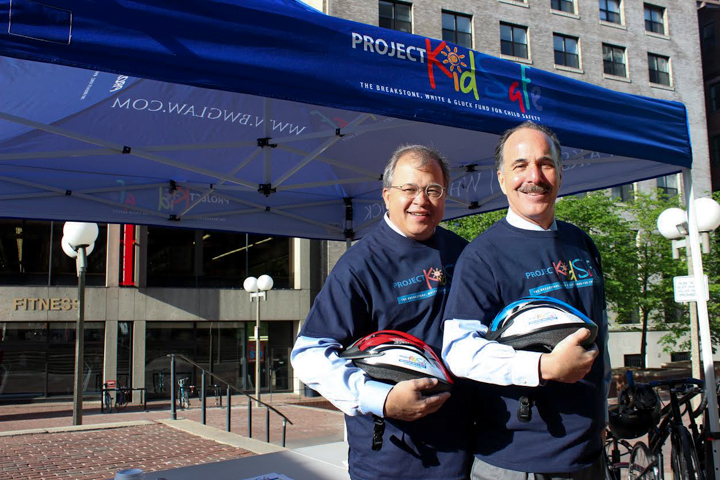
Attorney David W. White and Attorney Marc L. Breakstone of Breakstone, White & Gluck participated in Bike Friday at Boston City Hall Plaza. The two attorneys were there to support the cyclists as they rode in and to share information about the firm’s Project KidSafe campaign.
Boston Bikes organizes Bike Fridays to celebrate those who ride their bikes to work and to encourage others. More than two dozen organizations and vendors signed up for today’s event. While 200 cyclists registered for the event, organizers estimated up to 350 cyclists actually pedaled in and enjoyed a free breakfast, courtesy of Boloco.
Breakstone, White & Gluck participated for the first time and set up our Project KidSafe tent to show support for the cyclists. Attorneys David W. White and Marc L. Breakstone were among the crowd waiting for the cyclist convoys, which came in from Lexington, Newton, Somerville and many other communities.
Other organizations which participated included MassBike, Boston Cyclists Union, Livable Streets Alliance, Hubway and Landry’s Bicycles.
Marc and David spoke to a number of cyclists about our Project KidSafe initiative, through which we donate bicycle helmets to children who need one in the Boston and Worcester areas. We have donated more than 4,000 bicycle helmets since 2013, through partner organizations such as CYCLE Kids of Cambridge, Somerville and Cambridge public schools, Bikes Not Bombs, Massachusetts Safe Routes to Schools, the Westborough Bicycle and Pedestrian Advisory Committee. We have also worked with Boston Bikes’ Roll It Forward program, which refurbishes used bicycles and donates them to city residents who may not otherwise have access to a bicycle.
After the event, Marc said, “It is rewarding for us to be able to give back to the community in a way that promotes safety for children. We look forward to continuing our Project KidSafe program, and to expanding it in the years to come.”
The next Bike Friday events are scheduled for June 26th, July 24th and August 28th. Read more about the event.
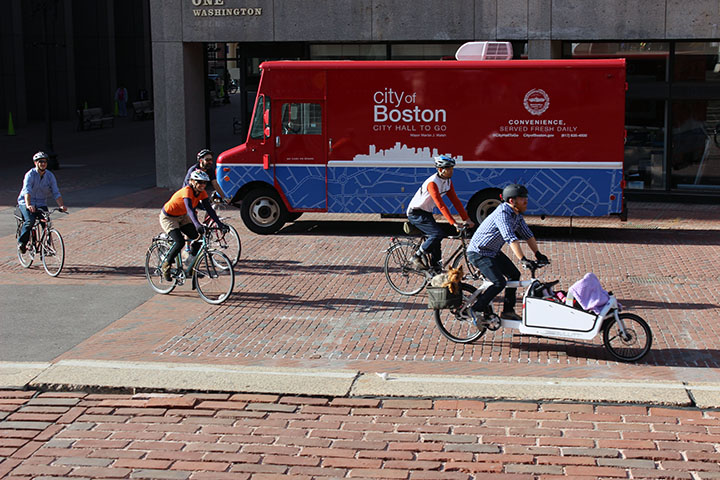
The cyclists came in in convoys this morning, traveling in from Lexington, Arlington and other communities. While 200 cyclists registered in advance, organizers estimate 350 actually rolled in.
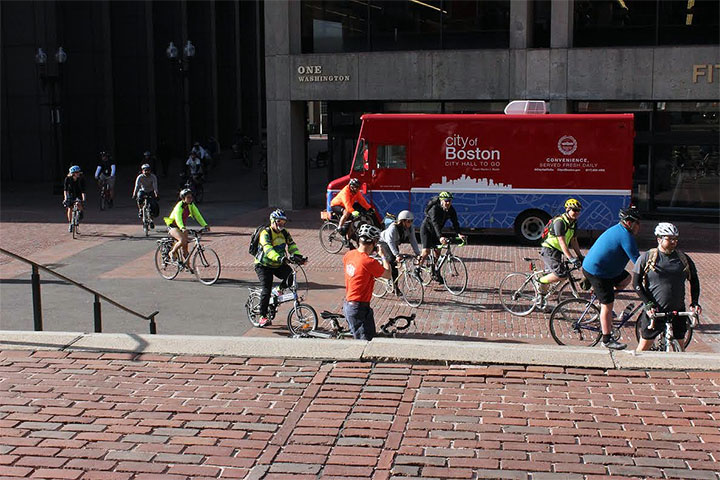
Parents: Time to Talk to Teen Drivers About Safety
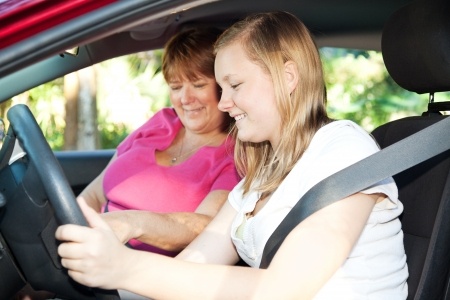 With the snowbanks nearly gone, your teen driver is likely asking for the car keys. Now is a very good time to talk to them about paying attention on the roads and following traffic laws.
With the snowbanks nearly gone, your teen driver is likely asking for the car keys. Now is a very good time to talk to them about paying attention on the roads and following traffic laws.
Young people ages 16 to 19 are nearly three times more likely to be in a fatal motor vehicle crash than other age groups. While cell phone use is a frequent cause, there is also simple inexperience. If you are a parent, you know this conversation takes a lot of work and a lot of repetition.
We offer these safety tips for teen drivers:
- Always wear your seat belt.
- Keep your hands on the wheel and your eyes on the road.
- Do not take phone calls while driving. The caller can leave a voicemail.
- Remember that under Massachusetts Junior Operator License, teen drivers are not allowed to use cell phones behind the wheel. You cannot send texts or make phone calls. If you are caught, you may be fined and your license suspended. It is important to think about these steps for the safety of others and to keep yourself out of trouble.
- If you must use your phone, pull off the road to a safe area. Put the car in park and remove the keys. Or ask a passenger to call or answer for you.
- Travel with the phone in the best place to reduce distraction. If your phone ringing or lighting up with messages distracts you, set it in a bag in the backseat.
- Remember that whatever is happening on your phone can wait, whether it is a social media post, e-mail or photo. It really can.
- Be mindful of distractions created by loud music or intense conversation. Explain to passengers you need to limit conversation while driving.
- Remember you cannot carry passengers under the age of 18 during the first six months with a Massachusetts Junior Operator License. The one exception is you can drive with siblings.
- Do not look up phone numbers or GPS directions on your phone while driving.
- Many cars have dashboard GPS systems and infotainment systems. Turn them off until you are more experienced.
Other Safe Driving Habits
- Never consume alcohol and drive. No driver should, but you are more likely than older drivers to get in car accidents because you lack driving experience.
- Before entering your vehicle, look around for other cars, trucks and hazards. Make sure you provide bicyclists and pedestrians extra time to pass.
- Shift your eyes every two seconds and check the rear-view mirror every five to eight seconds. This will help you focus on driving.
- Do not drive drowsy. If you are tired, you will be less capable of responding to potential car accidents. The Massachusetts Junior Operator License restricts young drivers from traveling between 12:30 a.m. and 5 a.m., unless accompanied by a parent. This is a good step but realize you always have to be aware of your fatigue level and make good decisions at all hours.
- Even if you have your license, keep practicing. For instance, if you are weak backing up, practice backing into a parking space in an empty parking lot with a parent. Keep practicing because you will need these skills going forward and will not always have the time to practice.
- There are construction work zones in many places. Be extra attentive, slow down and watch for workers.
- Check your speed regularly and slow down. A little extra space between you and the car in front of you can make a big difference toward preventing a car accident.
- Drive defensively. Expect the unexpected will happen and you may have to stop or change lanes.
- Signal your intentions to turn or switch lanes early enough to give others time to prepare.
- Do not drive on the highway on your own before you are ready.
- Limit the number of times you drive your friends home after sports practices, to the mail or school events. Every teenager looks forward to driving around with their friends, but teens are more likely to become distracted this way.
- Be careful in school zones and school buses. Slow down and watch out for teenagers and children walking or riding bikes. You are required to stop when school buses stop.
Drive Safely Through Road Construction
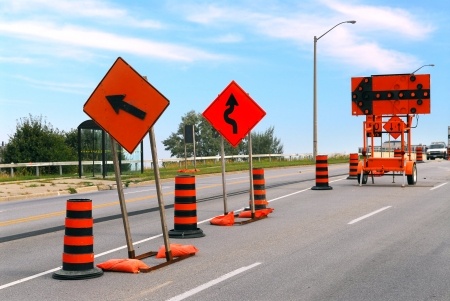 We have all looked forward to Spring this year, waiting for those snowbanks to finally melt so we can drive and walk and ride our bikes more easily. But we will face other challenges soon as construction projects return to the roads.
We have all looked forward to Spring this year, waiting for those snowbanks to finally melt so we can drive and walk and ride our bikes more easily. But we will face other challenges soon as construction projects return to the roads.
National Work Zone Awareness Week is now being observed by safety officials across the country. The annual campaign is held at the start of construction season to encourage safe driving through highway work zones and construction sites. The goal is to protect drivers, passengers, construction workers and others from injuries.
Drivers
- Drivers and passengers are at the greatest risk in a construction zone, accounting for an average of 85 percent of the deaths in highway work zone crashes, according to the Federal Highway Administration (FHA).
- In 2010, 576 people died in work zone crashes, the equivalent of one work zone fatality every 15 hours in this country, according to FHA.
Construction Workers
- Construction workers face many risks on highway work zones. In 2013, 105 construction workers died at road construction sites in this country, according to the Bureau of Labor Statistics (BLS). Other injuries are not included in this figure.
- Transportation accidents accounted for 66 percent of roadway work zone fatal occupational injuries in 2013. In 69 percent of these cases, a pedestrian worker was struck by a vehicle. Backing vehicles out accounted for 27 of the 48 pedestrian vehicular accidents.
Safety Reminders for Drivers
- Move Over. It’s the law in Massachusetts and most other states. Make sure you move over when you see construction signs and lights. And if additional room is not available, slow down.
- No Speeding. In Massachusetts, you can face double the original fine for speeding in a work zone and cause a serious car accident.
- No Distracted Driving. Pay extra attention to the roads as you travel through work zones; reduce distractions in your car from information systems and passengers.
- No Cell Phone Use. Eliminate distracted driving. Do not use your cell phone to text, check e-mail or social media. If you need to use your phone, use a hands-free system.
- Expect the Unexpected. You may not have any notice of a work zone until you are stuck in it. Be patient and be prepared to follow the signs and traffic cops and flaggers. This may mean not following the traffic signals at times.
- Pay Attention to the Signs and Look for Alternate Routes. Look for signs which direct you to detour routes and share other important information. Do not use your GPS until you are safely outside of the construction work zone.
- Mass511. The state’s traffic information system may help you avoid construction areas. Visit the webpage or call.
Safety Reminders for Pedestrians
- Use crosswalks in construction areas if it is safe to do so. If not, follow pedestrian pathways which have been marked by the construction operation.
- Watch how traffic flows before you step out into the street. You may be able to identify a safer path.
- If you know you will be walking through a work zone, consider carrying a neon glow vest and wear it as you cross a street. You want to stand out to road traffic, police officers and flaggers and the construction crew.
Safety Reminders for Cyclists
- Cyclists want to learn about roadway construction ahead of time. After all, there is nothing much worse than a mile of recently milled black top to shake your fillings loose. Call the local town or city hall or call the Mass511 service.
- Some of the cycling clubs in the Boston area also do a good job of alerting members of safety issues. One popular source of information is the Charles River Wheelmen’s safety articles. Look for cycling clubs in your area and ask if they offer a members forum or a newsletter.
Safety Reminders for Construction Workers
- Be vigilant about following OSHA and other safety procedures of your profession.
- If you are working on foot, make sure you are always aware of any vehicles around you and where there are flaggers and traffic cops.
Related links:
- National Work Zone Awareness Week.
- Highway Work Zone Accidents, by the Centers for Disease Control and Prevention.
Former Employees: Takata Hid Airbag Defects
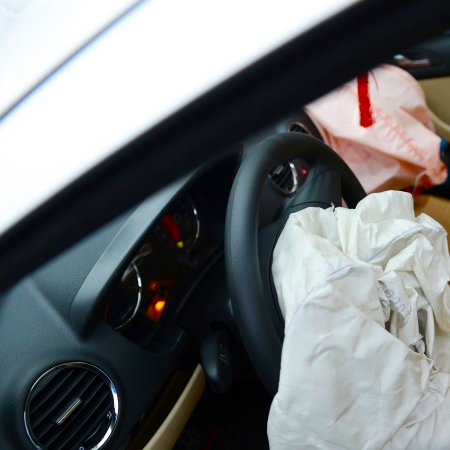 Long before the deaths and injuries, Takata knew its airbags were defective, according to two former employees of the company.
Long before the deaths and injuries, Takata knew its airbags were defective, according to two former employees of the company.
In fact, Takata knew about the defects as far back as 2004, the workers told The New York Times. The Japanese company learned one of its airbags exploded and sent metal debris spewing at a driver in Alabama, then began secret testing at its U.S. headquarters in Michigan. The testing was conducted outside normal work hours and was never disclosed until now. Three months into testing, employees began to theorize the problem was the welding on the airbag’s inflator canister, but the investigation was shut down and employees were instructed to destroy all testing data.
It took Takata four years to report the faulty airbags in a regulatory filing. In November 2008, the first Takata airbags were recalled.
The law requires car manufacturers to report safety defects to the government within five days once they are identified. This year has seen the most auto recalls in U.S. history and some hefty fines for Toyota and General Motors for failing to disclose defects. In March, Japan-based Toyota agreed to pay $1.2 billion to the U.S. government to avoid prosecution for hiding “unintended acceleration” defects. In May, General Motors was ordered to pay a record $35 million civil fine for failing to disclose deadly ignition switch defects.
Starting in 2008, Takata’s airbag recalls continued slowly, then got a big push last month from the National Highway Traffic Safety Administration (NHTSA). NHTSA issued a consumer advisory which urged drivers to immediately check if their vehicle’s airbags had been recalled and arrange for a repair. To date, 11 car manufacturers have recalled more than 14 million vehicles worldwide. Four deaths have been linked to the defective airbags and at least 139 people have been injured.
A few notes about this story:
Check Your Car. Every driver should check if their car has been recalled at SaferCar.gov. You can also read our blog for answers to many common consumer questions. Most impacted drivers will have to wait for replacement airbags so it is best to call your local dealer as soon as possible. Some carmakers are advising drivers not to carry passengers until their airbags have been replaced.
Why the Airbags are Defective. The airbags are defective because they have a steel canister which can crack when the device deploys in a car crash, sending metal, plastic and chemicals exploding at drivers and front seat passengers. The airbags have an inflator, which is comprised of a propellant based on a common compound used in fertilizer.
Honda. One question going forward is: How much did Honda know? This matters because Honda made more than 5 million of the recalled vehicles. The New York Times reports a 2002 Honda Accord was involved in the 2004 accident in Alabama. Honda officials say Takata assured them the accident in which a driver was injured by a ruptured airbag was an “anomaly.” Honda settled the case with the driver but Takata began its own secret testing, according to the employees. The NHTSA has ordered Honda to produce all its documents related to the Takata airbag recall by Dec. 15, so we may learn more then.
About Breakstone, White & Gluck
The Boston product liability lawyers at Breakstone, White & Gluck have over 100 years combined experience representing clients injured by negligence in Massachusetts. If you have been injured, learn your rights. For a free legal consultation, contact us at 800-379-1244 or 617-723-7676 or use our form.
Breakstone, White & Gluck Donates 150 Bike Helmets for Children in Westwood
Westwood families received free bike helmets for their children and learned about cycling and pedestrian safety at Westwood Town Day on September 27th.
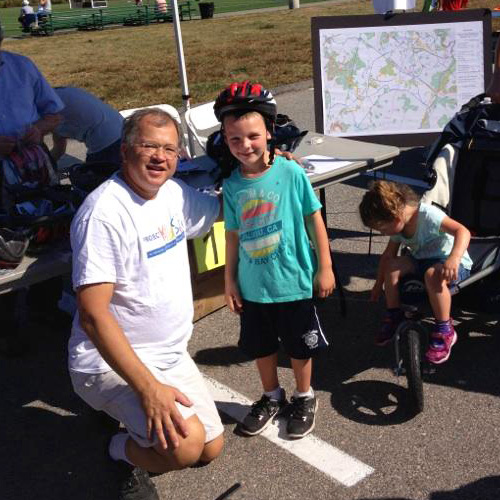
The Westwood Pedestrian and Bicycle Safety Committee hosted an informational table at the town celebration which was held at the Westwood High School. Breakstone, White & Gluck donated 150 bike helmets which were distributed to children age 16 and younger. The helmets went quickly at the annual event, which offers a fireworks display, music, food and road races for adults and children over the course of two days. Committee members fit children for the bike helmets and explained the importance of always wearing them. Attorney David White, a Westwood resident and committee member, helped fit the helmets.
In Massachusetts, children age 16 and younger are required by law to wear bike helmets. Cyclists of all ages should wear helmets to protect themselves and reduce the risk of head and brain injuries. Many cyclists neglect to do this. In fact, less than half of all cyclists actually wear helmets, according to the Centers for Disease Control and Prevention.
Breakstone, White & Gluck donated the helmets as part of Project KidSafe, our community service project to help prevent injuries among children. Our firm’s specialty is handling personal injury cases for those who have been injured, so we know firsthand the importance of injury prevention. We are devoted to keeping children safe. This is the second year we have donated bicycle helmets to organizations around the state. So far, we have donated over 2,000 helmets.
Read More

